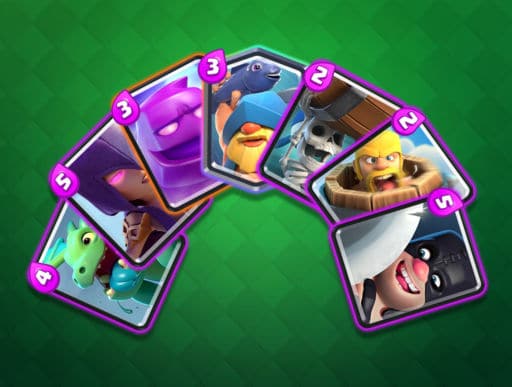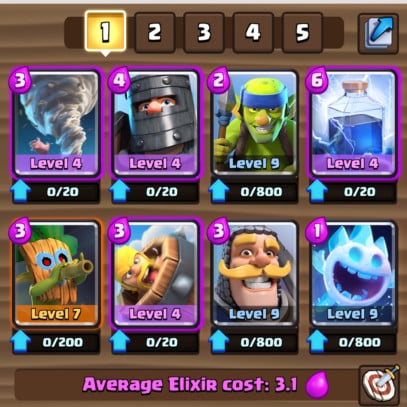Clash Royale offers a variety of deck types, each with its own playstyle and strategic approach. Understanding what decks are is essential for mastering the game. In this article, we will delve into the five primary deck types in Clash Royale: beatdown, control, siege, cycle, and hybrid. We will explore the strengths and weaknesses, and provide examples of each deck type along with their average elixir cost and card composition.
Due to the difficulty of obtaining higher rarity cards for newer players, we wanted to use focus on non-champion centric decks for this guide. The principles of the deck types would remain the same. Keep an eye out for when we release champion-specific deck guides. In the meantime, if you have a close call or an absolutely demoralizing victory to share? Be sure to showcase your Clash Royale clips on the Z League App today.
Table of Contents
Beatdown Decks
A beatdown deck type in Clash Royale is designed to create a formidable offensive push by utilizing a core tank unit backed by supporting units, overwhelming the opponent’s defenses, and swiftly demolishing their towers. This deck type boasts several strengths, such as its high damage potential, effectiveness in breaking through defenses, and its exceptional performance during double and triple elixir bonuses. Beatdown decks do have their weaknesses, including vulnerability to fast-cycle decks, heavy reliance on expensive units, and the need for meticulous elixir management. The most common meta beatdown decks include the golem, lavaloon, and royal giant beatdown decks.
Golem Beatdown Deck
- Average Elixir Cost: 4.8
- Cards: Golem, Baby Dragon, Mega Minion, Night Witch, Lumberjack, Lightning, Tornado, and Electro Dragon.
- Build a massive push by placing the Golem at the back and supporting it with high-damage units. Control the field with spells and defensive placements.
LavaLoon Beatdown Deck
- Average Elixir Cost: 3.9
- Cards: Lava Hound, Balloon, Mega Minion, Tombstone, Lightning, Arrows, Skeletons, and Baby Dragon.
- Deploy the Lava Hound followed by the Balloon to create an aerial assault. Use support troops to clear the way and protect your high-damage units.
Royal Giant Beatdown Deck
- Average Elixir Cost: 4.4
- Cards: Royal Giant, Furnace, Lightning, Baby Dragon, Mega Minion, Electro Dragon, Guards, and Barbarian Barrel.
- Utilize the Royal Giant’s long-range attack to chip away at enemy towers while defending against opposing threats. Establish control with Furnace and defend efficiently.
Control Decks
A control deck type focuses on maintaining control of the battlefield, effectively countering the opponent’s moves, and gradually gaining an advantage through fighting alongside your towers to set up counter pushes. Control decks have strong defensive capabilities, versatility in countering opponents’ strategies, and the ability to control the tempo of the game. On the other hand, control decks suffer from potential limitations in offensive power, the requirement for precise timing and card placement, and vulnerability to heavy beatdown decks. The most common meta control decks include the X-bow, mortar, and P.E.K.K.A control decks.
X-Bow Control Deck
- Average Elixir Cost: 3.1
- Cards: X-Bow, Tornado, Skeletons, Archers, Ice Spirit, Tesla, Log, and Fireball.
- Defend with Tesla and Tornado while placing the X-Bow for a strong counter-attack. Control the battlefield with versatile support troops.
Mortar Control Deck
- Average Elixir Cost: 3.0
- Cards: Mortar, Log, Rocket, Archers, Skeletons, Tesla, Ice Spirit, and Fireball.
- Place the Mortar defensively and chip away at the opponent’s towers. Control the battlefield using defensive structures and counter-attack opportunities.
P.E.K.K.A Control Deck
- Average Elixir Cost: 3.7
- Cards: P.E.K.K.A, Electro Wizard, Poison, Zap, Bandit, Mega Minion, Bats, and Battle Ram.
- Defend with P.E.K.K.A and support troops, then counter-push with surviving units. Control the tempo of the game and punish opponents’ mistakes.
Siege Decks
A siege deck type focuses on utilizing long-range troops or buildings to attack from a safe distance and chip away at enemy towers. A siege deck’s strengths lie in its robust defensive capabilities, the ability to force opponents into reactive plays leading to mistakes, and its proficiency in gradually wearing down opponent’s towers over time. Siege decks tend to be weaker in direct confrontations, require precise placement and timing of troops, and can be vulnerable to heavy beatdown decks that prioritize overpowering with sheer force.
Royal Giant Siege Deck
- Average Elixir Cost: 4.0
- Cards: Royal Giant, Furnace, Log, Lightning, Baby Dragon, Mega Minion, Electro Dragon, and Guards.
- Defend with Furnace and control the battlefield while using Royal Giant as the primary siege unit. Support the Royal Giant with other troops and spells.
X-Bow Siege Deck
- Average Elixir Cost: 3.1
- Cards: X-Bow, Tornado, Log, Archers, Skeletons, Tesla, Ice Spirit, and Fireball.
- Establish defensive structures and use the X-Bow as the primary offensive threat. Defend and counter-attack strategically while controlling the battlefield.
Mortar Siege Deck
- Average Elixir Cost: 3.0
- Cards: Mortar, Log, Rocket, Archers, Skeletons, Tesla, Ice Spirit, and Fireball.
- Defend with Tesla and Mortar while utilizing chip damage to wear down the opponent’s towers. Control the tempo and capitalize on counter-attack opportunities.
You may notice that the X-Bow and Mortar decks are exactly the same as their Control deck type counterparts; the reason why the deck type is different is in how the cards are being used to achieve the win. This further shows why Clash Royale is not an easy game, with how versatile the cards are, players who are trying to climb the ranks must understand there is more than one way to use almost every one of the 109 cards in the game, even if they are in the same deck. This is one way Clash Royale delivers satisfaction within its gameplay.

Cycle Decks
A cycle deck type revolves around the utilization of low-cost cards and efficient elixir management to create a continuous stream of pressure, outpacing the opponent’s card cycle. Cycle decks excel in rapidly cycling through their cards, enabling quick responses and offering multiple win conditions. Their strength lies in their high elixir efficiency, allowing players to consistently maintain control of the battlefield. However, cycle decks often rely on the lower individual strength of their cards, necessitating precise timing and meticulous elixir management to optimize their effectiveness. They can be vulnerable to heavy beatdown decks that prioritize overwhelming force and can exploit the cycle deck’s relative fragility.
Hog Cycle Deck
- Average Elixir Cost: 2.6
- Cards: Hog Rider, Ice Spirit, Skeletons, Cannon, Log, Fireball, Musketeer, and Bats.
- Cycle through your low-cost cards to keep applying pressure with the Hog Rider. Control the tempo, defend efficiently, and capitalize on Hog Rider pushes.
Mega Knight Cycle Deck
- Average Elixir Cost: 3.2
- Cards: Mega Knight, Skeletons, Bats, Zap, Fireball, Musketeer, Inferno Tower, and Skeleton Barrel.
- Cycle through your cards quickly while utilizing the Mega Knight as a defensive and offensive powerhouse. Counter-attack and maintain pressure on your opponent.
Goblin Barrel Cycle Deck
- Average Elixir Cost: 2.8
- Cards: Goblin Barrel, Knight, Princess, Log, Rocket, Inferno Tower, Skeleton Barrel, and Ice Spirit.
- Cycle through your low-cost cards to keep opponents guessing and apply constant pressure with the Goblin Barrel. Defend efficiently and use the Rocket as a win condition.
Hybrid Decks
A hybrid deck type in Clash Royale blends elements from various deck types. Its strengths lie in its versatility and adaptability, combining the strengths of different deck types and providing multiple win conditions. A hybrid deck may lack specialization in certain strategies and requires a deep understanding of different playstyles by the player. It can be vulnerable to highly specialized decks specifically designed to exploit its lack of specialization. Despite its weaknesses, a well-constructed and strategically played hybrid deck offers a unique advantage, allowing players to dynamically adjust their approach and keep opponents on their toes.
Here is a breakdown of 3 meta hybrid decks including the giant double prince, graveyard bait, and lava loon hybrid decks:
Giant Double Prince Hybrid Deck
- Average Elixir Cost: 3.8
- Cards: Giant, Dark Prince, Prince, Baby Dragon, Mega Minion, Zap, Poison, and Guards.
- Utilize the Giant as the main tank, supported by the Double Prince combo. Adapt your strategy based on your opponent’s playstyle and control the battlefield with spells.
Graveyard Bait Hybrid Deck
- Average Elixir Cost: 3.6
- Cards: Graveyard, Knight, Goblin Barrel, Princess, Log, Inferno Tower, Skeletons, and Poison.
- Bait out the opponent’s spells and defenses using Goblin Barrel and Princess, then punish with Graveyard. Defend efficiently and adapt your strategy based on the opponent’s counters.
LavaLoon Hybrid Deck
- Average Elixir Cost: 3.9
- Cards: Lava Hound, Balloon, Mega Minion, Tombstone, Lightning, Arrows, Skeletons, and Baby Dragon.
- Combine the aerial assault of Lava Hound and Balloon with strong defensive capabilities. Adapt your playstyle based on the opponent’s defenses and control the tempo of the game.



